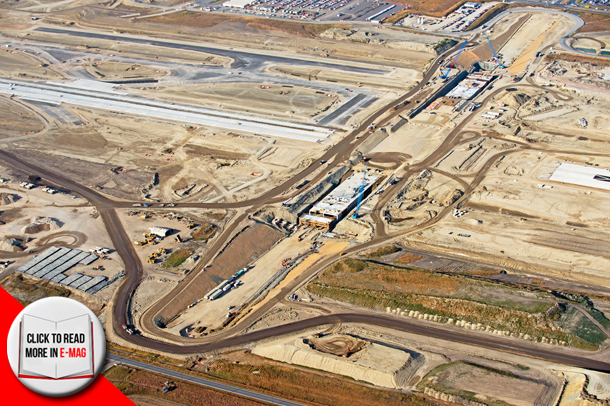Calgary Airport Trail Tunnel: Reducing congestion and delay for motorists
By: Fadeke Adegbuyi
The City of Calgary’s Airport Trail Tunnel Project has been in the works since the late 1990s. With the expediting of the Calgary Airport Authority’s Runway Development Project, the associated 620-metre tunnel is now on schedule to be completed in May 2014. The tunnel will run under the Airport Authority’s new runway and accommodate six lanes of traffic. It is approximately 36 metres wide. The tunnel will extend Airport Trail from Barlow Trail to 36 Street N.E. The $295 million budget for the tunnel is being funded jointly by The City of Calgary and the Government of Alberta’s Municipal Sustainability Initiative. The fund aims to provide sustainable funding for Alberta’s municipal infrastructure projects in order to keep the province’s municipalities strong. The project is considered to be the most expensive major road project undertaken by The City of Calgary to date.
Duane Delaney, the Manager of the Major Road Projects division at City of Calgary’s Transportation Infrastructure for the last nine years, has overseen the Airport Trail Tunnel Project. Prior to work with The City of Calgary, he was a consultant with EBA Engineering. There, he was involved in airport development and the construction of airport infrastructure. Delaney says, “the tunnel became a necessity much sooner than expected.” The completion of the Airport Trail Tunnel will be significant to the city.
Prior to the project commencing, a significant environment assessment was conducted to ensure that potential environmental impacts of the project would be mitigated. The tunnel will reduce the congestion and delay experienced by motorists. Delaney notes that the project will support the growth and development occurring in the northeast quadrant of the city. The tunnel will also provide another option for east-west connection at the north end of the city. Additionally, the tunnel will help to service the expanding airport in respect to airport traffic and the significant number of employees who work at the Calgary Airport. Delaney says, “the city has no tunnels of this size, length, or complexity.” It is expected that the tunnel will promote economic development citywide.
At present, it is anticipated that the project will be completed slightly ahead of time and within the allocated budget. However, the project was not without its challenges. The Calgary Airport Authority was building its new runway in the same area at the same time, which created scheduling complications. Delaney says, “We overcame the challenge with a good relationship between the contractors working on each project.” The site conditions also proved to be a challenge. Approximately 600,000 cubic metres of dirt and hard rock had to be excavated in order to construct the tunnel. Due to sensitive electronic equipment in the area, the construction team was prohibited from blasting. Utilising a different approach, work was conducted using Vermeer terrain levellers. This mechanism allowed for the rock to be broken up and reused for other areas of the project. The excavation stage progressed 24 hours per day, seven days per week.
Thankfully, due to proper preparation no damage to the tunnel was sustained due to the June 2013 Alberta floods that devastated Calgary. A sophisticated dewatering system was in place to keep up with the overland flows that resulted from the tumultuous rain events. Delaney attributes the overall success of the project to the seamless work of the PCL/Parsons/Dufferin ATT Joint Venture providing Construction Management Services.
The project took an innovative approach to construction that led to the receipt of an award at the Alberta Chapter of the American Concrete Institute 2013 Awards of Excellence. A large tent structure was erected in order to ensure ideal temperatures for quality control of the concrete. During the summer, liquid nitrogen was used to cool concrete so temperature specifications were maintained. Delaney adds, “this is usually done using ice, but we wanted to try something new.” Utilizing a “travelling form” method when constructing the outer-shell of the tunnel saved a significant amount of time. The entire project utilized advanced machinery and innovative methods throughout each phase of construction.
Delaney stressed that the tunnel project is a City of Calgary undertaking and a City of Calgary asset. He says, “We will be leasing the land through the airport authority via the federal government.”
Delaney closes, “the project is very important to citizens of the city of Calgary and we’re looking forward to the tunnel opening next May.”







